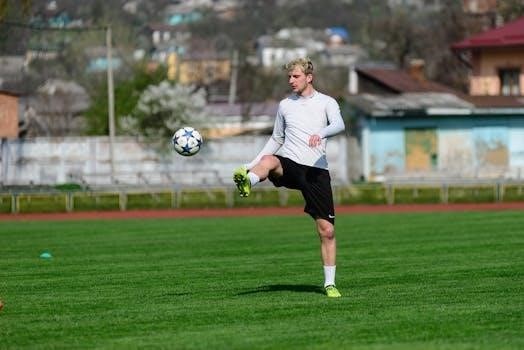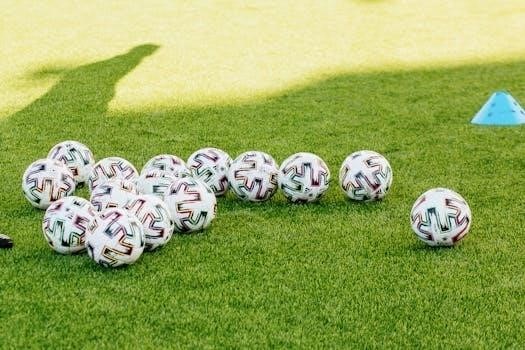Individual soccer training drills are crucial for player development, focusing on specific skills like passing, dribbling, and shooting․ These drills can be accessed through online PDFs, offering a wealth of resources for coaches․
Importance of Individualized Training
Individualized training is paramount in soccer, allowing players to hone specific skills at their own pace․ Unlike team practices, these sessions focus on personal weaknesses and strengths, leading to more well-rounded athletes․ By using resources like online PDFs, players and coaches can access a wide variety of drills tailored to individual needs․ This targeted approach ensures that each player receives the attention necessary for improvement, whether it’s enhancing passing accuracy, dribbling techniques, or shooting power․ Furthermore, it allows for a more personalized training regime, accommodating different learning styles and physical capabilities․ Ultimately, individualized training cultivates a deeper understanding of the game and elevates personal performance to benefit the whole team․ The ability to work on specific areas provides an advantage․

Technical Skill Drills
Technical skill drills are vital for developing a player’s ball control, passing accuracy, and shooting ability․ PDFs provide various exercises to enhance these fundamental soccer skills․
Passing Accuracy Exercises
Passing accuracy exercises are fundamental for developing precise ball distribution, essential for effective team play․ Drills often involve targets, cones, or teammates, emphasizing controlled passes with varying distances and angles․ One-touch passing variations can be incorporated to improve speed of play and decision-making․ Using the weaker foot is also crucial for developing well-rounded players․ Different types of turns before passing can further challenge players, enhancing their overall passing skill․ Coaches can find numerous passing drills in PDF formats, which also include diagrams and instructions․ These resources are invaluable for structured training sessions, focusing on improving players’ passing skills, thus leading to more effective possession and attacking opportunities․ The aim is to develop consistent and precise passing abilities․
Dribbling Techniques and Control
Dribbling techniques and control are vital for individual ball mastery, allowing players to navigate through opponents and maintain possession․ Drills often involve cones, markers, or designated areas, focusing on close ball control and changes of direction․ Utilizing both feet is crucial for developing well-rounded dribbling abilities․ Players should practice dribbling at varying speeds and with different surfaces of the foot․ Combining dribbling with turns adds complexity and improves the player’s ability to maneuver in tight spaces․ Online resources, including PDF documents, offer a wide array of dribbling drills with diagrams and instructions․ These drills aim to enhance a player’s agility, coordination, and overall comfort with the ball, essential for successful game performance․ Consistent practice is key to improving dribbling skills․
Shooting Practice Drills
Shooting practice drills are essential for improving a player’s goal-scoring ability, focusing on accuracy, power, and technique․ Drills often incorporate various shooting scenarios, such as shots from different angles, distances, and with different parts of the foot․ Players should practice shooting both with and without pressure․ Utilizing targets and goals of various sizes can help with accuracy improvement․ Many online PDF resources provide a range of shooting drills, including those that focus on first-time shots, volleys, and headers․ Practicing different types of shots and techniques will enhance a player’s overall scoring capability․ Regular and varied shooting practice is key to becoming a proficient goal scorer․ Coaches can use these drills to develop a player’s confidence in front of the goal․

Physical Conditioning Drills
Physical conditioning drills are vital for soccer, focusing on agility, speed, and endurance․ Online PDFs offer varied exercises to improve players’ overall fitness levels and match performance․
Agility and Speed Training
Agility and speed training are fundamental components of soccer conditioning, enhancing a player’s ability to quickly change direction and accelerate․ Drills often incorporate cones and ladders to improve footwork and reaction time․ Players can use various exercises to focus on short bursts of speed and rapid movements․ Such training is not just about running fast in a straight line but also about being nimble and reactive on the field․ These drills, found in many soccer training PDFs, help players gain a competitive edge by increasing their dynamic movement capabilities․ This type of training contributes to improved overall performance and injury prevention during matches․ Agility and speed work should be a regular part of individual soccer training․
Endurance Building Exercises
Endurance building exercises are essential for soccer players, allowing them to maintain high performance throughout matches․ These exercises, often detailed in soccer training PDFs, focus on improving cardiovascular fitness and stamina․ Players can incorporate long-distance running, interval training, and various other exercises to build endurance․ This includes exercises that simulate the stop-start nature of soccer․ Consistent training in this area helps players maintain their energy levels and effectiveness until the final whistle․ Improved endurance also aids in quicker recovery between sprints and plays․ These drills ensure players have the capacity to perform consistently at their best․ This type of training is crucial for all soccer players․

Tactical Awareness Drills
Tactical awareness drills, often found in soccer PDFs, enhance decision-making skills․ These drills include 1v1 scenarios and small-sided games, improving players’ understanding of game situations and positioning․
1v1 Receiving and Turning Drills
1v1 receiving and turning drills are essential for developing a player’s ability to control the ball under pressure․ These drills, often outlined in soccer training PDFs, focus on receiving the ball while being closely marked by a defender, emphasizing quick turns to create space and play forward․ Typically, a 7×7 yard area is used, with four players and two balls per group, where the focus is on turning and receiving the ball effectively while under pressure․ These drills help players improve their ability to make quick decisions and maintain possession, enhancing overall tactical awareness․ They also encourage players to use different turns, such as inside and outside of the foot, to further challenge their skills․
Small-Sided Game Scenarios
Small-sided game scenarios, often detailed in soccer training drill PDFs, are vital for enhancing tactical understanding and decision-making․ These games, like 3v3 with outside players, focus on specific objectives, such as scoring through wall passes․ These scenarios help players learn how to effectively use space, support teammates, and quickly transition between attack and defense․ The drills encourage players to make quick decisions, improve their passing accuracy, and develop their spatial awareness․ Utilizing small-sided games also fosters teamwork, communication, and problem-solving skills within a game-like environment․ These scenarios provide an enjoyable and engaging way for players to improve their tactical abilities․

Resources for Training Drills
Online drill databases and PDFs offer a variety of soccer training resources․ Software tools also help in creating structured training plans with diagrams, often available in PDF format․
Online Drill Databases and PDFs
Numerous online platforms provide extensive databases of soccer training drills, often available in convenient PDF formats․ These resources are invaluable for coaches and players seeking to enhance their skills and tactical understanding․ Many sites offer free drills, covering various aspects of the game from technical skills to physical conditioning․ These PDFs frequently include diagrams and detailed instructions, making it easy to implement drills during training sessions․ Coaches can use these databases to find suitable drills for different age groups and skill levels․ The ability to download and print these PDFs allows for easy access on the field․ Furthermore, some databases offer categorized drills, allowing users to search for drills that focus on specific areas, such as passing, shooting, or defending․ This wealth of easily accessible resources can significantly improve the quality of soccer training․
Software for Creating Training Plans
Specialized software is available to aid coaches in designing effective training plans, often incorporating drills found in PDF databases․ These programs, like TacticalPad, allow coaches to create animated drills in 2D or 3D, which can be displayed on phones, tablets, or desktops․ Such software often includes a variety of tools for drawing and customizing drills, making it easier to visualize and share training sessions․ Many of these applications allow users to save their plans in PDF format, facilitating distribution among coaches and players․ Some platforms focus on managing training sessions with a wide variety of tools that can be saved in PDF format․ This technology offers a significant improvement over traditional methods, offering more efficient and creative ways to plan and implement training regimes․ This helps in making training more effective and engaging․
Advanced Drill Variations
Advanced drills combine multiple skills, such as dribbling through cones before passing and shooting, offering a more challenging and engaging training session․ Rondo drills can also be adapted․
Multi-faceted Skill Combination Drills
These drills are designed to integrate various soccer skills into a single exercise, promoting a more holistic approach to training․ For instance, a drill might involve a player dribbling through a series of cones, followed by a precise pass to a teammate, and concluding with a shot on goal․ This type of multifaceted approach not only enhances individual skill levels but also improves players’ ability to transition smoothly between different aspects of the game․ Such combinations ensure players are not just proficient in isolated skills but can effectively apply them in dynamic, game-like scenarios․ Utilizing these drills allows players to become more adaptable, versatile, and ultimately, more effective on the field by combining dribbling, passing, and shooting skills in one fluid action, thus mirroring game situations more closely․ These drills are essential for a player’s comprehensive development;
Rondo Drill Adaptations
Rondo drills, a staple in soccer training, can be adapted in numerous ways to enhance various skills․ One common adaptation involves incorporating one-touch passing, thus increasing the pace and precision of play․ Another variation focuses on using the weaker foot, improving overall player ambidexterity․ Further adaptations include changing the direction of play, forcing players to quickly adjust their positioning and passing angles․ These adaptations can be tailored to the specific needs of the players․ Another version may include a player in the middle needing to win the ball back, increasing the intensity of the drill․ These adaptations ensure that the rondo drill remains a valuable tool for improving decision-making, passing accuracy and awareness of space and teammates․ These adaptations keep players engaged and continuously challenged․